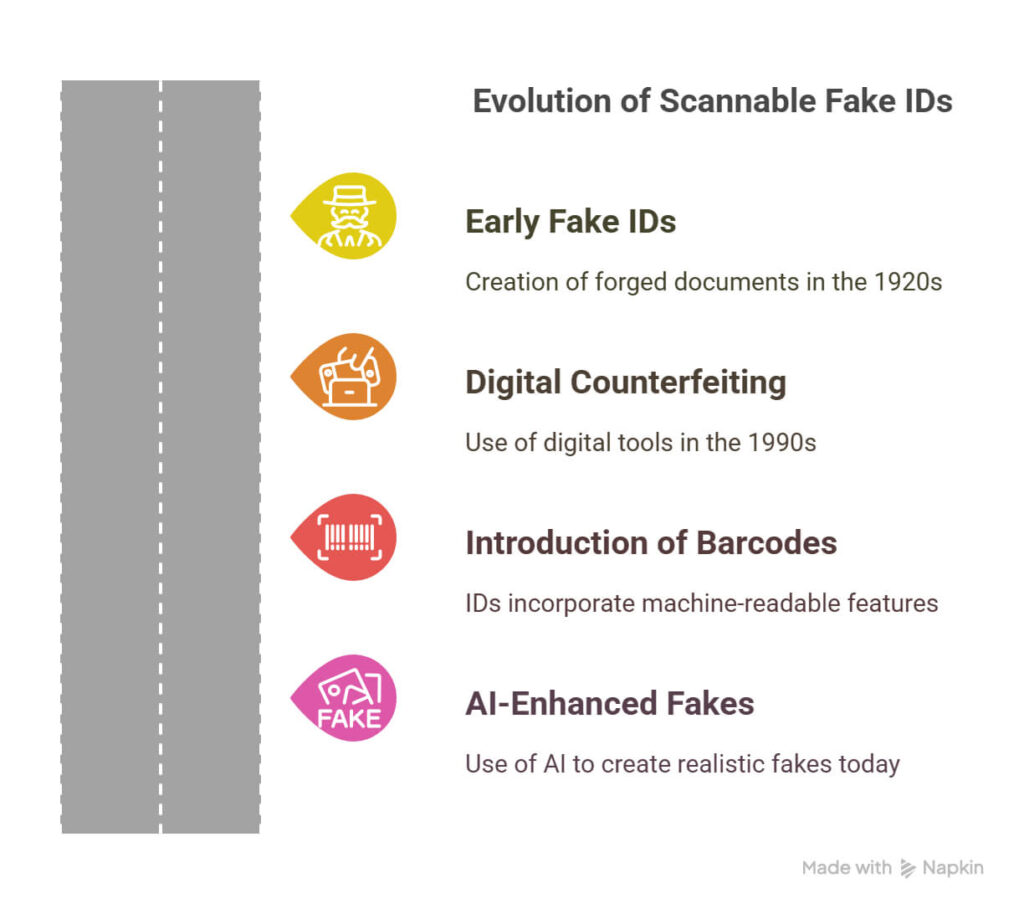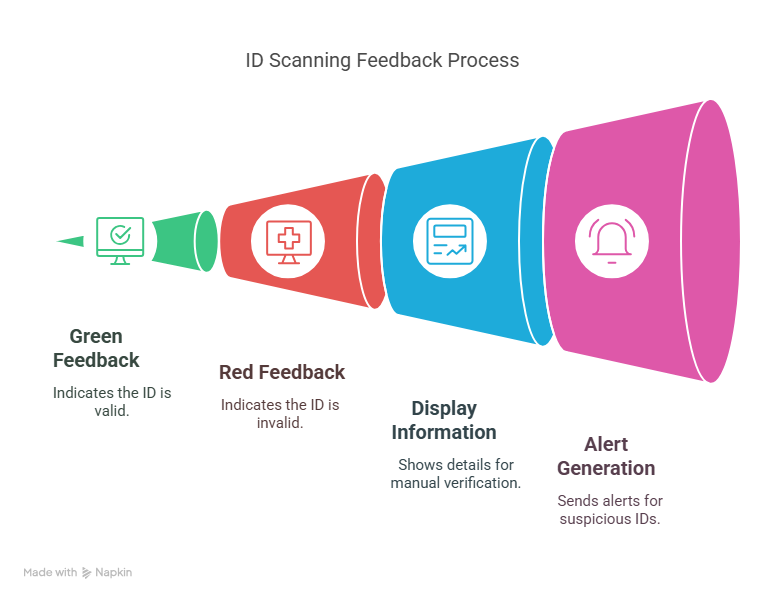How Do Scannable Fake IDs Work?
Let’s be honest — fake IDs aren’t what they used to be.
These days, some of them do way more than just look real. They actually scan. They pass swipe tests. They even fool legit systems with barcodes and encoded data.
That’s because of a scannable fake ID — and if you’re thinking about getting one, or just curious how they work, you’re in the right place.
In this post, I’ll break down how these fraudulent IDs are made, how they manage to trick ID scanners, and what separates a real-looking fake from one that actually works.
What is a Scannable Fake ID?
A scannable fake ID is a replica card that can pass barcode or magnetic strip scans like a real ID. It stores fake but convincing data, allowing it to pull up information when swiped.
Unlike basic novelty IDs that only look legit, scannable versions interact with ID scanners — making them harder to detect and more reliable in real-world use.
How Do Fake IDs Become Scannable?
Scannable IDs work because they don’t just look real — they’re built to act real too. Fake ID makers use tools like barcode generators and magnetic strip encoders to copy what legit government issued IDs do behind the scenes.
Here’s how it works:
- Barcode printing: A special software creates barcodes that hold data like your name, DOB, and address — just like a real license.
- Magnetic strip encoding: Some IDs have strips programmed with fake, but convincing, info that scanners can read.
- Database mimicry: High-end versions even match formats used by real systems to trick basic scanners into accepting them.
That’s how these cards can pass a swipe—not just a glance.
Evolution of Scannable Fake IDs
Fake IDs have been around since at least the 1920s, starting with forged documents used during prohibition to access speakeasies and restricted areas.
Back then, it was all about visual mimicry — changing photos, forging signatures, and copying fonts to trick human eyes.
By the 1990s and early 2000s, digital printing and photoshop made it easier for counterfeiters to create cleaner, more convincing cards. But they still mainly relied on visuals.
Everything changed when government-issued IDs began using barcodes and magnetic strips. These features made IDs machine readable, and forced ID card makers to evolve again.

Now, it wasn’t just about how the identification card looked, but what data it could show when scanned.
Today’s scannable fake IDs go even further. Some use AI-based tools to create realistic, high-resolution cards that pass both human checks and electronic scans.
It’s become a constant back-and-forth: tech improves, so do the fakes—and so do the scanners trying to stop them.
How Do Fake ID Scanners Really Work?
Most fake IDs can fool a quick glance — but scanners can catch the information your eyes might miss. They look past the surface and dig into what’s stored in the card.
Here’s how it works, in simple words:
1. First, the Scanner Reads the Card
When the card is swiped or scanned, the machine pulls info from the barcode or magnetic strip. Things like:
- Your name and birthday
- Address, ID number, expiration date
- Sometimes even the issuing state or country
If the card has extra tech like a chip or watermark, higher-end scanners might pick that up too.
2. Then It Checks the Details
After pulling the data, the scanner would check if it’s actually built the way a real ID should be. That means:
Are all the fields there?
Is the data in the right format?
Any weird characters or missing info?
If something’s off, that’s a red flag.
3. It Might Also Check a Database
Some scanners go a step further. They compare the ID’s data against real records — either government databases or internal systems (like bars keeping track of banned customers).
If what’s on the card doesn’t match, it gets flagged.
4. You Get a Quick Result
Once all that’s done, the scanner gives feedback:
Green means good
Red means nope
Or it might just show the info on a screen so the bouncer or clerk can double-check it

In some places, scanners also send alerts if something fishy comes up.
5. It Might Catch Extra Stuff Too
AI-enabled advanced scanners can also spot:
- UV marks or holograms
- Microtext that’s hard to fake
- Signs of tampering, like scratches or lifted laminate
Those little details are harder to copy—but they help weed out cheap fakes.
Why Are Fake ID Scanners So Effective?
Fake ID scanners are effective because they go beyond visual checks. They read barcodes, analyze data formatting, verify information against real databases, and detect tampering — all within seconds. This multi-layered process makes it much harder for fake IDs to pass undetected.
How Do ID Verification Systems Detect Fake IDs?
Modern ID verification systems catch fake IDs by checking more than just appearance. They scan the data, compare it with official records, and look for security features most fakes miss.
1. Barcode & Data Check
Each state uses a specific format for encoding ID data. Scanners read the barcode or magnetic strip, then check if the structure and fields match what’s expected. If anything’s off—wrong length, missing info, odd formatting—the system flags it.
2. Real-Time Database Verification
Some systems cross-check the scanned data with government or private databases. If the ID number, name, or birthdate doesn’t match up with real records, it gets rejected. This step is what stops most high-quality fakes from slipping through.
3. Visual Security Feature Detection
Legit IDs have built-in security elements—like holograms, UV watermarks, and microtext. Advanced scanners can detect these using UV or infrared light. Fakes usually miss these fine details or get them wrong.
No single method works alone, but together, these layers make it incredibly hard for counterfeit IDs to pass. That’s why businesses—from bars and banks to airports—trust these systems to verify who’s real and who’s not.
Do Scannable Fake IDs Actually Work?
Yes, they can — if they’re made right.
A well-made scannable ID can pass basic swipe tests at bars, clubs, and even some security checkpoints. The barcode or magnetic strip pulls up believable data, just like a real license would.
But not all replica IDs are created equal. If the card is poorly made, uses low resolution barcodes, or has mismatched info, scanners will flag it or show an error.
That’s why quality matters. The right tools, correct data formatting, and attention to detail make all the difference when it comes to passing a scan.
That’s why where you get your ID matters.
At TopFakeIDs.com, we craft scannable IDs designed to mimic the structure, data formatting, and features of real ones. So if you’re going to use one, you need something that doesn’t just look legit — it has to act real too.
How to Spot a Fake ID Without Getting Fooled
Let’s be honest — some forged IDs out there are just plain obvious.
Others?
You’d think they are real – but how do you tell the difference?
Here’s what I’ve learned after seeing both the good and the garbage.
Start With the Feel
When you hold an ID, trust your gut. If it feels flimsy, has jagged edges, or the lamination looks like it was rushed, that’s already a bad sign.
Look for small stuff most people overlook:
- Holograms that don’t shift right under light
- Fonts that are just slightly off
- Spacing that doesn’t line up clean
- Corners that feel like they’ve been peeled or pressed
Real IDs are made to last.
Fakes?
Not so much.
Scan It If You Can
An identification scanning software will tell you more than your eyes ever could. The barcode or mag stripe should match what’s printed on the card.
If the scan pulls up a different name, wrong date of birth, or no info at all? Game over.
Also — some fake IDs reuse the same barcode over and over. If your scanner sees that barcode more than once, you know what’s up.
Don’t Just Rely on One Check
Here’s the truth: even good ID card scanners miss things. And even a rough-looking ID might pass if no one double-checks.
That’s why layered checks matter. Glance at the physical card. Scan it. Run it through a database, if you’ve got one. No single method is perfect — but together, they’re pretty solid.
Why It Matters?
Scannable fakes aren’t just for getting into bars. People use them to open bank accounts, rent cars, cross borders, or worse.
And when businesses don’t catch them? They pay the price—fines, lost licenses, even legal heat.
It’s not just about protecting your business. It’s about protecting people, too.
Not All Fakes Are the Same
Some are trash. Some look good but fail a scan. And a few—yeah, a very few—actually work.
That’s why at TopFakeIDs.com, we don’t mess around. Every ID we make is designed to scan, swipe, and hold up under pressure. Because let’s face it, if it doesn’t pass the test, it’s just a waste of money.
However, I’d be advise to use your fake cards carefully and for fun only – otherwise you’ll have face legal consequences.
Final Thoughts
Scannable fake IDs aren’t just clever—they’re evolving fast. Some pass basic scans, others crash and burn the moment they’re swiped. What makes the difference? The details. The formatting, the barcode, the way it all comes together.
If you’re using one, or thinking about it, don’t get burned by a card that only looks legit.
Whether you’re trying to understand how they work or you’re looking for one that actually holds up under a scan, knowing what to look for makes all the difference.
And if you’re serious about getting a high-quality replica that doesn’t just pass the eye test—but the tech test too — TopFakeIDs.com has your back. We build them like they’re meant to pass, not just pretend.

